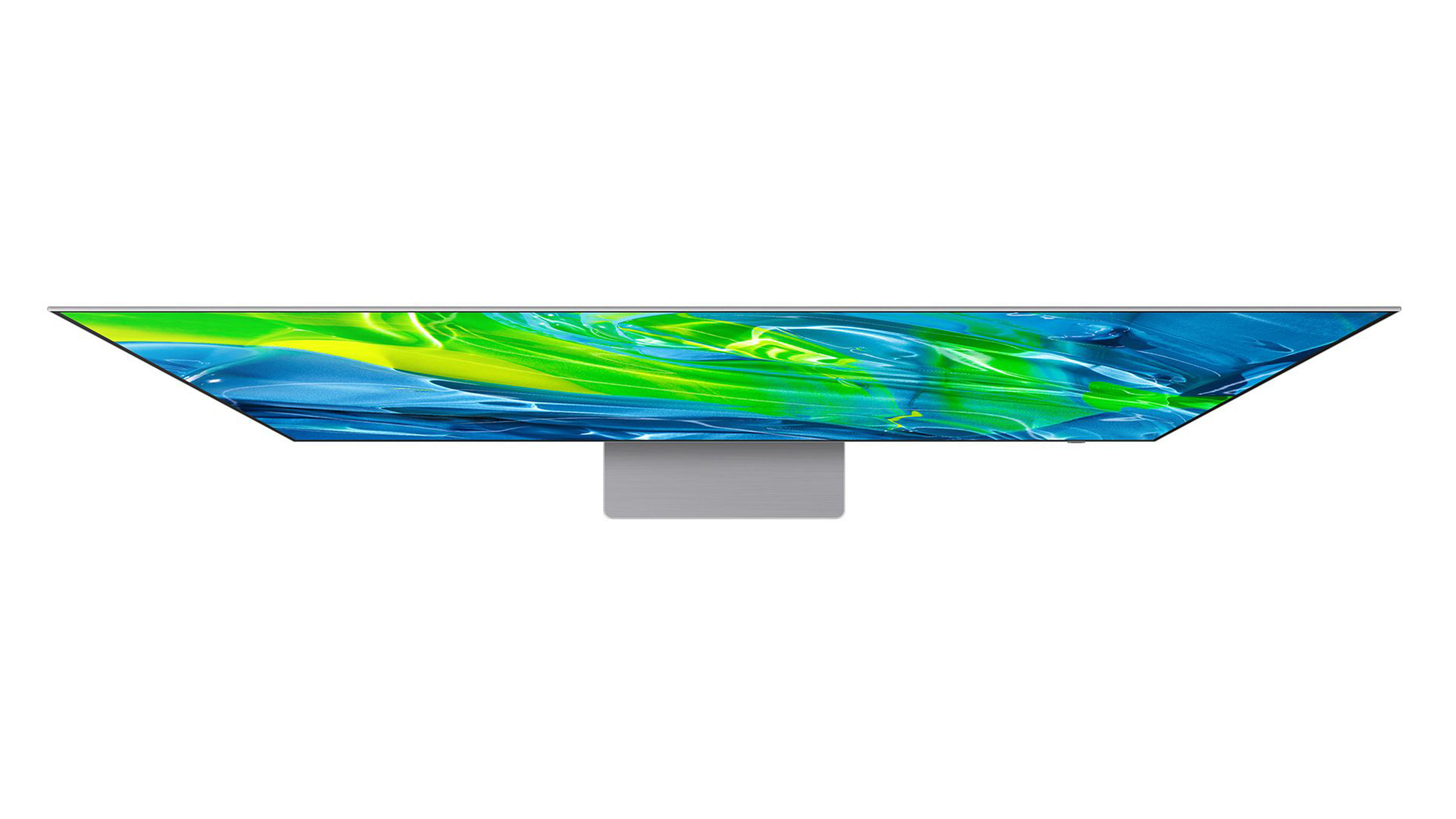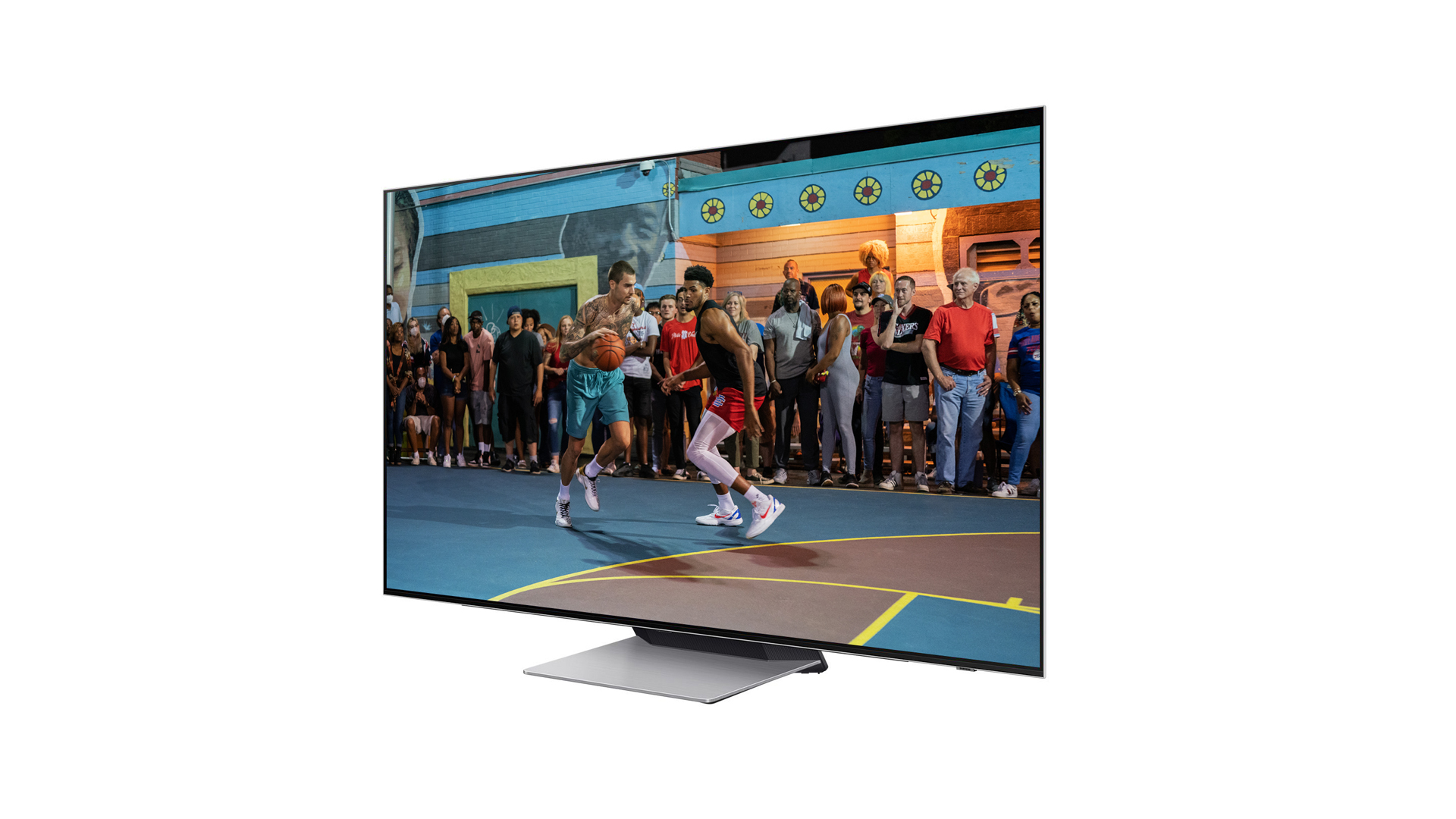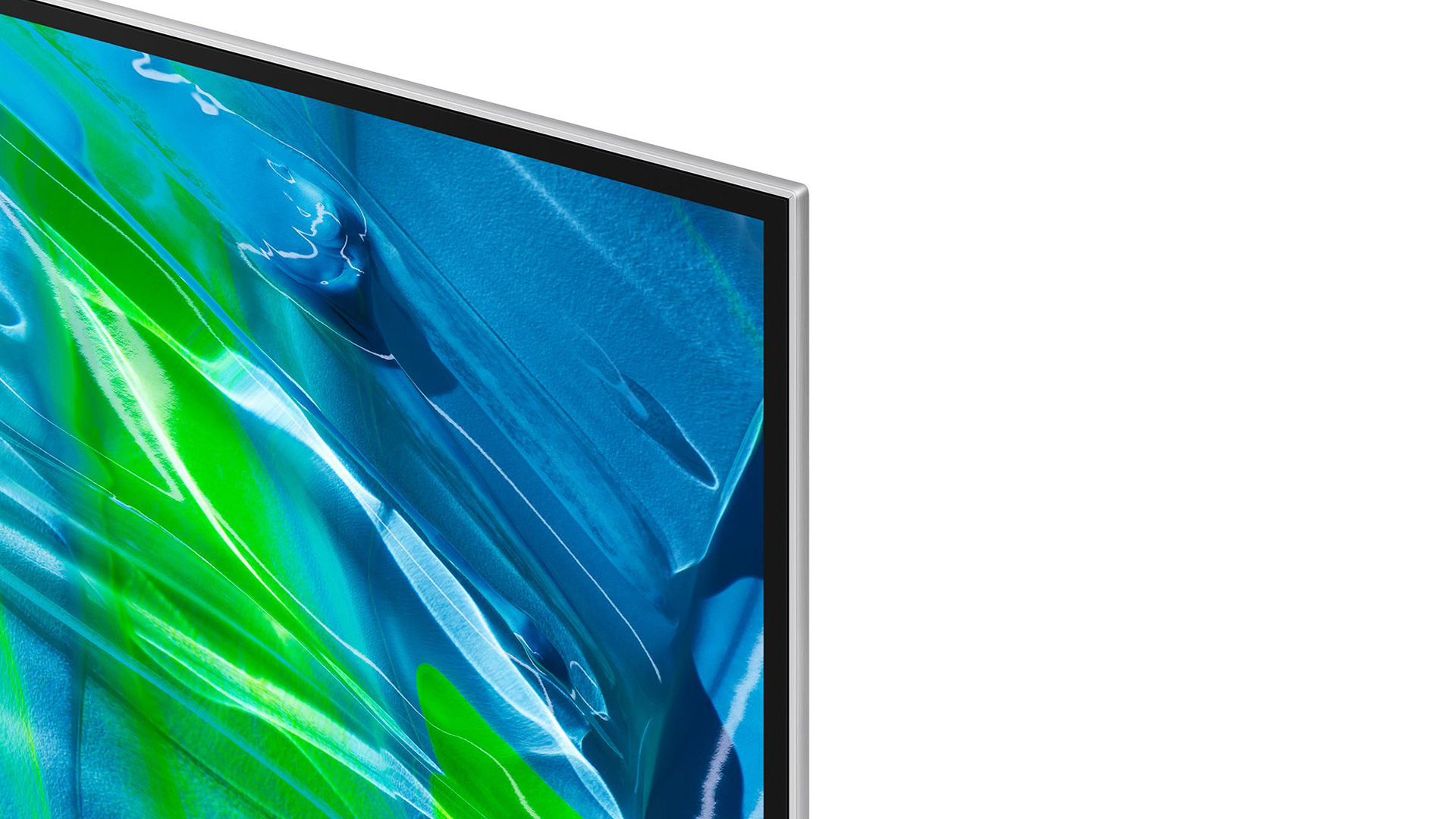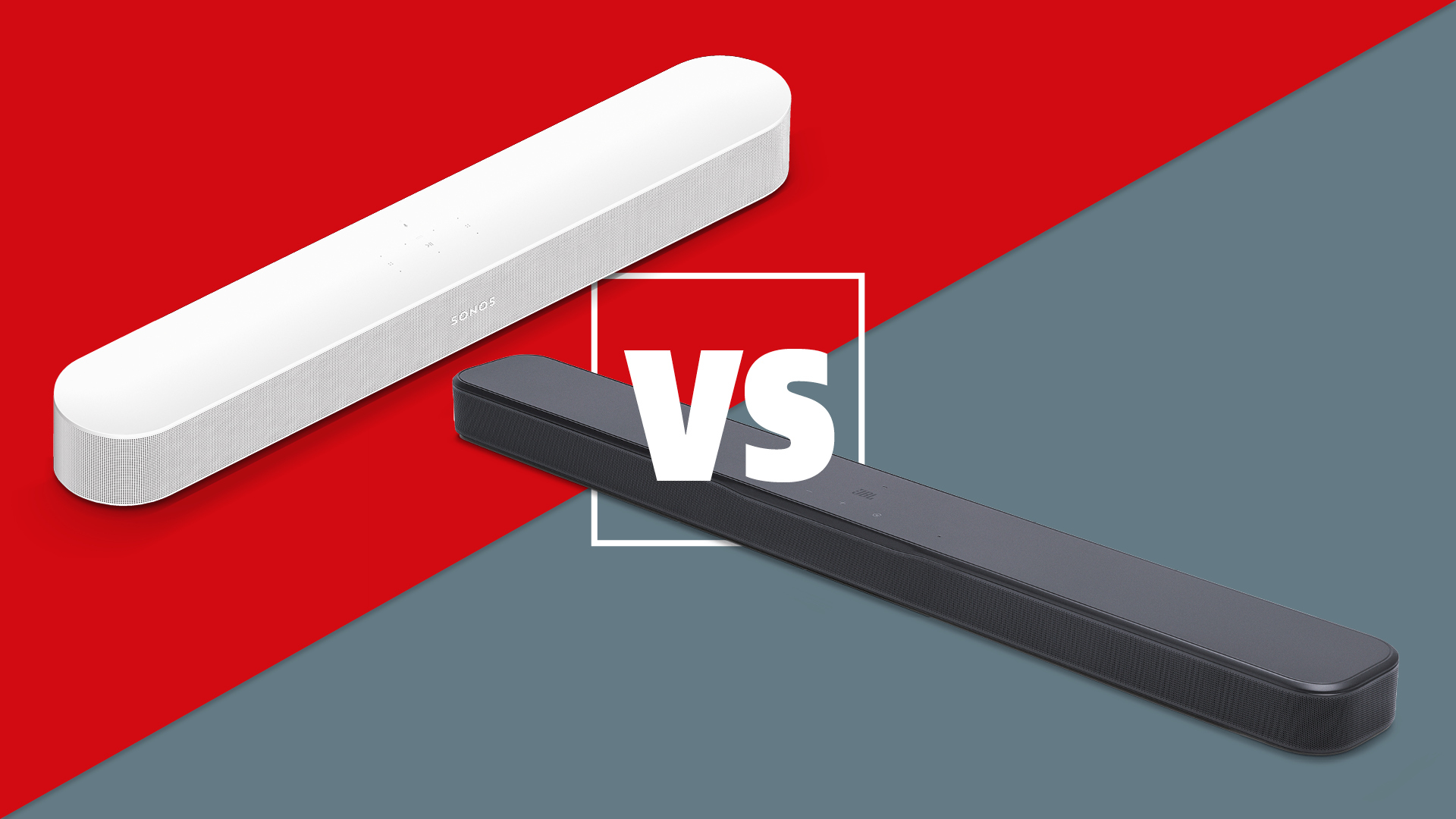What Hi-Fi? Verdict
While not always the most subtle performer, the S95B QD-OLED delivers thrills aplenty
Pros
- +
Spectacularly vibrant and dynamic
- +
Peerless viewing angles
- +
Excellent gaming support
Cons
- -
Needs tweaking for best results
- -
Imperfect skin tones
- -
Some brightness instability
Why you can trust What Hi-Fi?
In any sane AV world, we’d be lauding the Samsung S95B as the world’s first Quantum Dot OLED TV. After all, Samsung basically invented the technology, and has been producing it for commercial displays for a couple of years now. So, not surprisingly, pretty much all of the initial discussion around this exciting new TV technology was entirely focused on Samsung, and everyone just assumed Samsung would be the first (maybe even the only, for a year or two) brand to bring it to the living room.
Yet in the end, for reasons we can only speculate about, it was actually Sony that gave us our first QD-OLED TV in the glorious form of the A95K. So now, rather than just representing a new TV technology, the Samsung QN65S95B we have before us today has to be looked at in terms of how it holds up against a ground-breaking rival that beat it to the punch.
Price
The Samsung QN65S95B kicks off its campaign well by being widely available for significantly less than the Sony A95K: $2800 versus $4000.
Of course, $2800 is hardly small change, but we are talking about a brand new, potentially game-changing technology. So when you consider early adopters were expected to pay five figures for other ground-breaking technologies such as plasma and OLED when they first launched, it’s a pleasant surprise to find Samsung’s first 65-inch QD OLED TV actually slotting in at roughly the same price of a premium 'standard' OLED TV such as LG’s OLED65G2 (with its built-in heat sink); far below the price of its Sony QD-OLED rival; and even below the launch price of Samsung’s own premium 65-inch flagship 4K 'Neo QLED' Mini LED TV for 2022, the QN65QN95B.
Design

Samsung has marked the arrival of its first QD OLED TV with quite the design statement. The S95B really is incredibly thin over the vast majority of its rear – just a couple of millimetres deep, in fact. Since Samsung isn’t shipping the S95B with one of its external One Connect boxes, there inevitably has to be a chunkier section on the back of the TV’s bottom half. But even this is smaller and slimmer than such processing, connection and speaker-bearing segments on other otherwise super-skinny TVs tend to be, leaving the incredible thinness of the QD-OLED panel to define the S95B’s extraordinary look.
Sony’s A95K looks positively chunky by comparison. Though unlike the S95B, Sony’s QD-OLED model doesn’t bend and twist alarmingly while you’re setting it up. Do not under any circumstances attempt to fit the QN65S95B’s heavy, centrally mounted, metal-finished pedestal stand without someone to help you.
Looking at the QN65S95B from the front, the lack of bodywork surrounding the picture is also up there with the slimmest we’ve seen.
The latest hi-fi, home cinema and tech news, reviews, buying advice and deals, direct to your inbox.
The S95B supports Samsung’s Ambient Mode, which lets you play a wide selection of digital artworks or video screensavers on the screen when you’re not watching TV, so you don’t have to share your room with a 65-inch black hole.
As with all of Samsung’s premium TVs, the S95B ships with two remote controls: a regular one with lots of buttons, and a stripped-back ‘smart’ one. Both work well for different types of use, and the smart one impressively is powered by a built-in solar panel.
Features

The big story here, of course, is the S95B’s QD-OLED panel. This combines the self-emissive pixels of OLED with the Quantum Dot color system previously associated with LCD TVs, potentially delivering more brightness and, especially, color volume than regular OLED panels can manage.
The technology works by shining a blue organic LED through separate red and green Quantum Dot layers, avoiding the color-fading (at high brightness levels) of the white element that normal OLED TVs use.
Adding an OLED-based screen technology to its range after years of disparaging the tech seems to have given Samsung’s marketing department a few headaches. If it delivers the picture-quality goods, though, we somehow don’t think we’ll see many consumers complaining about Samsung’s change of tune.
The S95B’s all-new panel design is driven by a specially adapted version of Samsung’s Neural Quantum Processor 4K, complete with elements devoted to boosting brightness and color, enhancing perceived resolution and improving upscaling of sub-4K content.
Connectivity is impressive. In particular, all four of the provided HDMI ports are true 2.1 affairs, meaning they’re all able to cope with the 4K/120Hz HDR with VRR gaming graphics now supported by the PS5, Xbox Series X and certain top-end Nvidia and AMD graphics cards. Plus there are three USB ports and all the usual Bluetooth and wi-fi features you’d expect of a high-end TV these days, including support for SmartThings and Apple AirPlay 2.
The cutting edge HDMIs are far from the end of the S95B’s gaming story. It also supports ALLM so that it can turn into its fast response Game mode whenever a game source is detected, and input lag in that Game mode is just 9ms with 1080p/60Hz sources using the TV’s Fastest input lag setting (you can if you wish choose to tolerate a little more lag in return for improved motion performance with games that aren’t too based on reaction speeds). This is as low a figure as you’ll find anywhere in the TV world.
Then there’s the second generation of Samsung’s Game Bar, which lets you call up a readout of all the key info on your gaming feed, as well as providing access to key setting adjustments. Gaming-related features now include splitting the screen, four genre-based presets, 21:9 and even 32:9 aspect ratios if a game and your PC support them, and the option to raise the brightness threshold of dark areas of gaming pictures so that you can potentially make out enemies more easily.

Screen size 65 inches (also available in 55")
Type QD-OLED
Resolution 4K
HDR formats HDR10, HLG, HDR10+
Operating system Tizen
HDMI inputs x4
HDMI 2.1 48Gbps, x4
Gaming features 4K/120, VRR, ALLM, HGiG
Input lag 9ms
ARC/eARC eARC
Optical output Yes
Dimensions (hwd, without stand) 33" x 57" x 1.6"
Smart features are provided by Samsung’s latest Tizen interface, which delivers a complete revamp of the system found on Samsung’s 2021 models. The quantity of apps supported on this new Tizen iteration continues to be exemplary, including all the big hitting streaming services.
There’s also support for ‘Multiview’ picture in picture, no less than three built-in voice assistants (Samsung’s Bixby, Google Assistant and Alexa), a new Video Calling app (though you’ll need an optional extra external camera to use this), and Samsung’s increasingly curated and useful ‘TV Plus’ roster of streamed TV channels.
Unfortunately, though, the new interface feels much more cumbersome, hard to follow and generally unhelpful than its compact predecessor. Samsung has made some pretty unhelpful navigation choices, too (hitting Exit from the picture and sound adjustment menus, for instance, takes you to the home screen instead of back to what you were watching), and the system also runs sluggishly for a while every time you switch the TV on.
As with all of Samsung’s high-end TVs, the S95B supports the HDR10+, HDR10 and HLG formats of high dynamic range, but not Dolby Vision. It’s a pity Samsung’s TV division can’t join its soundbar division in burying the hatchet (or whatever it needs to do) with Dolby over Dolby Vision, but it doesn’t look like the situation is going to change any time soon.
Despite its insanely slender frame, the QN65S95B retains a couple of key audio features familiar from other Samsung high-end TVs. Namely Dolby Atmos playback (Atmos can also be sent out losslessly via HDMI eARC to compatible soundbars and AVRs) and Samsung’s Object Tracking Sound system, where sound effects appear to be coming from the correct part of the screen.
Picture

Fully prepared for the S95B to not live up to the QD-OLED hype, despite the success of Sony’s A95K, in fact we couldn’t suppress an involuntary ‘wow’ as soon as we clapped eyes on the Samsung set’s pictures.
The main source of this wow is the screen’s phenomenal contrast. On the one hand the S95B instantly delivers the sort of immaculate, ultra deep blacks long associated with the best of the OLED world, while on the other it delivers levels of brightness – both in small highlights and, even more noticeably, across the whole screen – that we haven’t seen before on any regular OLED TV. Including LG’s brilliant new G2 series.
Outstanding though it is, even Sony’s A95K QD OLED TV doesn’t deliver as much brightness alongside its perfect blacks as the S95B. So right away Samsung’s QD-OLED debutante is delivering something to differentiate it from anything else on the market.
Basically Samsung, as usual, seems more prepared to take the brakes off with its default Standard picture preset than most rival brands (with the possible exception of Philips). Perhaps especially so with the S95B, given that the company is no doubt keen to push the benefits of its new take on OLED technology since its great rival LG has dominated the OLED space for so long.
Spending more time watching more HDR sources on the S95B reveals that its lust for brightness isn’t, as you might have expected, at its most impactful in white parts of the picture. In fact you feel the impact of the panel’s extra luminance most in its colors – particularly yellows and reds. Put simply, the RGB rather than RGBW nature of the QD OLED picture enables Samsung’s new screen to unlock a level of color volume that we haven’t seen on an OLED-based TV before. While Sony’s A95K scored its biggest points over regular OLED on color volume too, its slightly more restrained approach didn’t yield quite such explosive results as the S95B.
If you want to witness the full, actually slightly crazy extent of what the S95B can do on the color volume front, give the TV’s Dynamic preset a quick spin with something like an animated HDR film or a bright, colorful movie scene such as the town pageant sequence from It on 4K Blu-ray. Tones across the board explode off the screen with a combination of brightness and potent saturations that experience says just shouldn’t be possible with OLED technology.
So aggressive is the Dynamic mode, though, that beyond looking at it purely out of interest, we really wouldn’t recommend that you stick with it. Its colors are so extreme that they go too far beyond the source material, losing the image’s balance and drawing too much attention to make for the sort of immersive experience most people will be looking for once they’re done showing off.
The Standard picture preset that we suspect most S95B users will feel most drawn to does a much better job of still providing plenty of impact from the screen’s brightness, contrast (including superb rendering of subtle shadow details) and color volume advantages without typically tipping the picture into unbalanced, unnatural territory.
It doesn’t get things perfect all the time, though. While most colors look gorgeous to an at-times unprecedented degree, there can be issues with skin tones. Occasionally they can look too heavily saturated, sometimes in dark scenes they can look too undersaturated and a little plasticky, and now and again specific skin tone areas can take on too strong a yellow or green tint.
There’s another, rarer issue with the mostly spectacular Standard mode, too, in the form of an occasional skip in brightness. Since this usually occurs during full-screen bright shots, we’re not entirely sure if it’s down to some sort of screen protection mechanism or something caused by one of the TV’s picture optimisation processes. You can stop it by turning off the Contrast Enhancer feature, but doing this also robs the image of a fair bit of the punch and dynamism that makes the Standard preset – and, to some extent, the QD-OLED technology – so exciting.
If you’re looking for an experience that still delivers some of the benefits of QD–OLED so apparent with the Standard mode, but with the occasional skin tone and instability niggles largely negated, then selecting the S95B’s Movie preset is a good quick-fix option. It’s nice, too, that unlike the Movie mode on many recent Samsung TVs, the one on the S95B delivers a palpably different experience to the more accuracy-focused Filmmaker Mode, being both brighter and more colorful.
In fact, kicking the Contrast Enhancer feature on in Movie mode is a useful option if you want to get a fairly ‘Standard’-like image without so many of the skin tone issues. Though since the Movie preset takes a more restrained approach to color, tones in very bright areas can become slightly faded with the Contrast Enhancer on unless you also adjust the TV’s color space setting to Normal – which can increase the skin tone inconsistencies again.
Following a recent firmware update, Filmmaker Mode does as it should – it provides a simple route to pictures that match pretty accurately the standards typically used in the home video mastering world. Compared to the Movie preset, though, we find it looks flat – but it’s important that it’s there.
Sharpness levels with both upscaled HD and native 4K are very good – though perhaps not quite as blisteringly crisp as those of Samsung’s premium 4K LCD TVs. The sharpness remains high when there’s motion in the image too – especially if you take the edge off the screen’s native judder with a touch of Samsung’s motion processing. Samsung’s default motion settings, however, tend to generate too many messy side effects – choose a custom mode with judder and blur both set to around level three and noise reduction off for the cleanest results, or potentially leave the blur element a bit higher if you want a bit more sharpness.
The S95B’s self-emissive screen joins regular OLED technology in delivering far wider realistic viewing angles than you get with any LCD TV. It also impresses by delivering its strong HDR brightness peaks with very little clipping (loss of subtle shading detail), and for suffering practically no color banding with video or gaming sources.
Talking of gaming, the S95B is a glorious gaming monitor. We can’t recall seeing a more all-round spectacular combination of brightness, color volume, sharpness, fluidity and responsiveness from our resident PS5 and Xbox Series X consoles than Samsung’s QD-OLED screen provides. Truly jaw-dropping stuff.
The S95B’s undoubtedly aggressive approach to game graphics can occasionally nudge towards a slightly blown-out look with some titles – Dirt 5 being probably the most glaring example. Changing the Color Space setting to Auto calms things down nicely, though.
The brightness instability issue noticed very occasionally with video sources crops up with some fast-paced games such as Dirt 5, too. This is less obvious than with video sources, but if you do find it irritating with a particular title, turning the contrast enhancer feature off improves (but doesn’t completely remove) the problem.
If you find yourself sat unhealthily close to the screen when gaming, the screen’s use of an unusual triangular sub-pixel structure can mean a hint of reddish fringing around the edges of stand-out image details – white text against a dark background, say. However, it’s not something we could say we felt distracted by with gaming or video images watched from a sensible viewing distance.
The extent to which we found we had to tweak multiple facets of the S95B’s pictures to get results that feel consistent as well as spectacular is a touch frustrating, and perhaps serves as a reminder that this is, after all, Samsung’s first QD-OLED TV. Certainly we’d like to see Samsung develop some sort of dedicated skin tone processing next time out – or even add one via a future firmware update.
It’s worth adding that the S95B does support Samsung’s smart calibration system, where you can calibrate the TV to a decent degree of accuracy using nothing more than an app on your mobile phone. Also, be in no doubt that while the S95B needs more manual intervention than either the LG G2 or the Sony A95K to consistently get the best from it, the rewards for your efforts are so spectacular – and, in some ways, so unique – that your efforts end up just feeling like a labour of love.
Sound

The Samsung S95B’s audio is in some ways a pleasant surprise, given how insanely thin most of the TV’s bodywork is. With regular day-to-day TV audio and the relatively spartan talky scenes that actually make up most of a typical movie’s running time, the sound appears clean and nicely staged, with the OTS system doing a startlingly effective job of making specific sound effects appear as if they’re coming from the right place both on and slightly beyond the screen. Especially with Dolby Atmos mixes.
The biggest surprise, given our experiences with other Samsung TVs, is that the sound actually seems to have a forward dimension, rather than everything sounding as if it’s happening behind the screen. Dialogue, in particular, comes out at you rather than sounding swallowed and detached.
A dense action scene or hefty sustained low frequency effect, though, catches the S95B out. For starters, there just isn’t much bass at all, denying meaty soundtrack moments the sort of weight and dynamics they need to convince. This shortage of low-end grunt, together with a quite limited maximum volume, can contribute to the sound starting to lose intensity and impact just when it’s supposed to be shifting into top gear.
Really heavy bass effects can still cause the onboard speakers to crackle and buzz from time to time, too.
Verdict

Samsung’s S95B continues the journey started by Sony’s A95K towards convincing us that QD-OLED really is a genuine evolution in TV technology. In fact, by being brighter and bolder than the Sony, it makes you even more aware of the technology’s potential.
Samsung’s more aggressive take can become a bit over-excited at times, requiring more regular tinkering with various settings than Sony’s milder but more consistent and natural approach. When it’s firing on all cylinders, though, which it is for the vast majority of the time, the S95B is glorious.
SCORES
- Picture 5
- Sound 3
- Features 5
MORE:
Read our review of the Sony XR-55A95K
Also consider the LG OLED65G2
Read our LG OLED65C2 review
Best OLED TV 2022: brilliant budget and premium OLED TVs
John Archer has written about TVs, projectors and other AV gear for, terrifyingly, nearly 30 years. Having started out with a brief but fun stint at Amiga Action magazine and then another brief, rather less fun stint working for Hansard in the Houses Of Parliament, he finally got into writing about AV kit properly at What Video and Home Cinema Choice magazines, eventually becoming Deputy Editor at the latter, before going freelance. As a freelancer John has covered AV technology for just about every tech magazine and website going, including Forbes, T3, TechRadar and Trusted Reviews. When not testing AV gear, John can usually be found gaming far more than is healthy for a middle-aged man, or at the gym trying and failing to make up for the amount of time he spends staring at screens.
